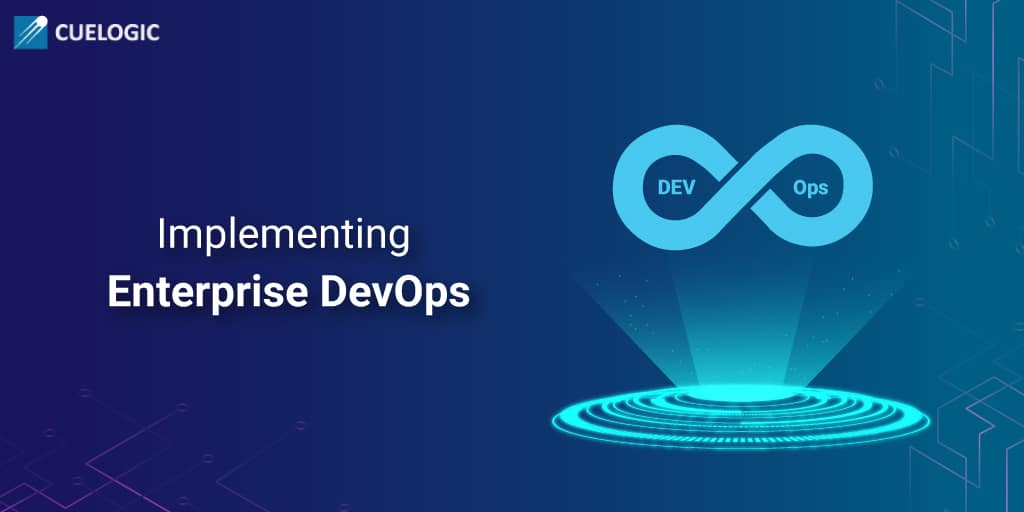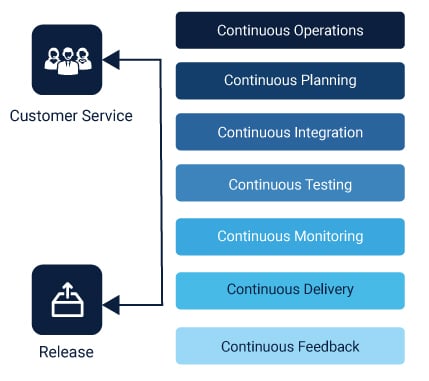So What Exactly Does DevOps Mean?
DevOps is simply a process that contains deployment, maintenance, security and management of the backend code of a software product. While the developers/programmers write the code and add new features, DevOps teams ensure the stability of all the systems that run the software and this process is all-encompassing.
The logo of DevOps is the symbol for infinity where processes from development to maintenance are intertwined with each other in the form of a never-ending loop. And rightfully so. However, implementing Enterprise DevOps can be a challenging task. Let’s have a look.
DevOps Are Constantly On The Line Of Quality Product Delivery
With the changing times, the need for digital transformation will keep increasing. DevOps principles and the teams that abide by them will be the chief drivers behind the development of new capabilities. The software product maintenance and operations is a more rapid process as compared to the delivery of the application. It helps propel business implementations through automation of delivery process pipelines. This leads to the desired business results.
However, implementing scaled-up DevOps in large and highly-regulated enterprises presents a unique set of challenges. Usually, these challenges involve issues such as monolithic systems, manual workflows, and dependence on legacy software and other general issues pertaining to large organizations, due to their scale and their timeline is inherently tougher and slow to mold.
Also, in traditional as well as in hybrid product development environments, the development and maintenance teams are scattered across the world. To top that, the constant need to maintain the product with regards to compliance, security and other factors can be inundating. So how can a company overcome this complexity?

Here are a few ways you can begin implementing enterprise DevOps effectively
- Use Your Current Working Base:The pace at which the digital economy is growing will set you on the path to innovating rapidly thus making you embrace new tech as well as business models. Therefore, in a time when the software industry, in general, wants to experiment with the “new”, big companies have already made large investments in offering top-notch infrastructure that manages aspects such as risk, security, and compliance.One can say that DevOps is not about removing and replacing currently used tools or infrastructure. This calls organizations to build capabilities on the current layer of infrastructure. For this to happen, toolchains are required to be open so that even hybrid IT environments can find support, during your transition from waterfall model to the agile model or when you are moving from mainframe to cloud-based services.It is all about moving constantly from point to point continuously while improving what you already have. Priorities in business, markets, and technologies are constantly on the move, which requires you to have solutions that create compatibility between the new and the old.Therefore, while implementing enterprise DevOps organizations that recognize the value of building new from existing assets will also outperform those who take the other route.
- Do Not Overload The Operational Process:The expectations of customers are usually high and the time until the deadline is short. The process of delivering value to clients needs aligning the business needs with your delivery process of your software product. This would include, removing constraints, manual work automation, and an increase in stakeholder’s visibility throughout all value streams.Another level of abstraction is suggested for large enterprises where the systems thinking approach is placed above individual pipelines for deployment. This understanding should be extended all the way upstream right from product delivery to the specific business request. This is so because if one wants to build a resilient enterprise, one needs to know the difference between how a system was intended to be built and how it is working currently.This would require organizations to focus on T-shaped skills with partners and teams. Course correction and making informed decisions come only on optimizing the value system, creating real-time visibility.
- Improve Business Confidence:The good news is that the speed of change of systems and quality can now go hand-in-hand, therefore companies should adopt DevOps implementations that help increase security, performance, and compliance. For being on the competitive edge, organizations require both speed as well as quality as they are making the transition to a culture where quality along with security is integrated with every endeavor.In many large companies, proprietary software justifies evolved business processes, services, and unique products. Therefore, you must be providing an environment where your business has the confidence to act aggressively without fearing repercussions of facing several risks.With the creation of new capabilities created for supporting the digital transformation of a given business, companies must make sure that quality, as well as security, are important components of the process right from the beginning.
https://www.financialexpress.com[/caption]
- Always Deliver Desirable Results:Is there a way for you to tell that your IT organization is creating a difference with regard to the business? Most of the IT companies complete projects to meet a predefined output. However, it isn’t necessary that if the company has created a product, the product is going to offer high-quality economic value. In the case of software development, its relationship with the customer and its subsequent effect on them is sometimes obscure.The measurement of one’s performance as a DevOps isn’t just limited to measuring one’s productivity and the output of a task and neither it’s an impact-making strategy. Therefore, DevOps isn’t something that you just do, but rather about the results of your work.Results are the positive outcomes that your customers get as a result of your work. To begin with, DevOps should start by taking stock of their customer’s needs such as their challenges, constraints, priorities, and issues that have tied them down. This can be made possible by deploying a system that offers a continuous feedback loop with the help of KPIs and real-time data in the DevOps toolchain. Without feedback, your company won’t deliver the products and the services required by the business. In the end, scaling DevOps standard practices on a larger and highly-controlled enterprise created unique challenges. These four methods/principles will help IT companies to develop better methods to deliver business output at a lot faster pace.
Source: https://www.indiatvnews.com[/caption]
- Implement Automation:DevOps provides many benefits, one of which is automating manual jobs that will bring down important projects. Big companies generally have the time, the budget and manpower to implement automated tools like CI/CD pipelines, integration and unit test suites and configuration management systems. However, the biggest challenge is that the organization has to make everyone happy.One of the most effective approaches is standardizing a single DevOps tool for every purpose like Chef or Jenkins. This will help your IT team to specialize in these given tools but also result in making some users not open to them as they might not be comfortable using them. The alternative solution can be having every team use the software of their preference.However, this can lead to a problem that can be loosely termed as “toolset hell” where a mashup of many applications will take place in your organization. Therefore, given that every approach has its own pros and cons, it is always the calling of the management.
- Having A Holistic Approach:The holistic thinking approach is a lot easier for large companies to visualize and implement since successful large organizations are already equipped with the systems that can help them see the larger picture, which can be accomplished either through management or the development team or even through a committee that works across functions.Having said that, the communication of this holistic approach up and down to the management and the employees respectively is very important for making the out of the box thinking possible, which can help you surmount roadblocks that are in your way of development and deployment for creating a product.Sometimes the difficulty in executing this comes not from the technical end, but rather making your developers realize that the code cannot solve all the problems.
- Making Teams Focus On Single Set Of Tasks:Making teams focus on a single set of tasks and handle their designated part of work and absolutely nothing extra is one of the biggest challenges that an enterprise can face when they are trying to implement DevOps principles.In large organizations, DevOps is generally divided into development and operations and therefore bridging them together can be a humongous task. Filling out the gap between ‘Dev’ and ‘Ops’ is what DevOps team seeks to get resolved.Some companies might solve this issue by creating a separate team that executes the cross-team tasks by making it possible for employees to migrate easily in between teams, specifically based on the given project and its applications. If you ask, the more DevOps-oriented approach would be to make use of ChatOps and documentations that enable open communication, that can help them to unify teams with distinct tasks.
- Quick Feedback:DevOps brings various types of feedback such as automated feedback which is typically about a specific piece of code, which mostly comes through unit testing and integration, personal feedback reported by other members of the team, consumer feedback given by the customers who have been using the product designed and developed by you as well as the cross-team feedback which you will get from across the organization.Here, unlike startups and small companies, large enterprises will need to consciously keep the intra-team and inter-team communication active.However, they will have an advantage that they can deploy more resources (in monetary as well as manpower terms) to get a customer as well as internal feedback about products in general and individual services. They are also in a position to buy and apply automated testing tools.
- Ensure A Long-Term Commitment:Achieving a proper DevOps is a process that runs in the long-term. Even though there are factors such as KPIs and metrics that can be easily monitored, assessment of progress towards a complete or to say the least, a satisfactory level of implementation can take time to achieve and to quantify.Having high expectations from both the development as well as operations teams, before the process initiates, is also necessary so as to preempt any sudden changes that may take place as teams move toward working in tandem and align their functions.People from the operations team will need to provide their developers with constant updates about the performance of their code in real-world conditions from the end-user point of view.The developer team, on the other hand, will need to focus on how their output will work in a distributed and cloud-based environment. Certain tasks, such as analyzing the log data may turn out to be a concern for both the team.Implementation of DevOps practices is a significant task that needs making significant changes to the development structure of an organization. If executed correctly, the advantages of this new method of executing version delivery are amazing and the results show significant improvement with regards to the delivery of upgraded software to the end-users.
- Improving The Innovation Process:DevOps is about innovating through the use of agile Development technology. With the use of DevOps, enterprises can overcome organizational silos and further scale their systems that can meet the ever-evolving needs of consumers as well as developers.As DevOps goes on improving the communications between the various teams and eliminates the need for silos in the organization, it becomes an easy task to work towards the unified goals set by the management.The agile implementation makes it possible to bring in automation and innovation which helps in enhancing the daily procedures and weeds out processes that are inefficient.
- Let The Transformation Process Be All-Inclusive:This is essentially means to getting everyone involved in the DevOps enterprise implementation. Here, one needs to get everyone on board works in unison toward one vision. Sharing knowledge, the will to succeed and common goals are characteristics of enterprises that want to implement its DevOps in the right way.It’s, therefore, a fact that enterprises that focus on the different DevOps aspects such as people, tools, and processes, rather than making isolated implementations, will experience an overall success.Enterprises need to realize that DevOps implementation is more like a journey rather than a move from one position to another. While the plan for a DevOps migration is being implemented, one needs to identify the various stages the enterprise will have to transition through. This ensures that there are no rude awakenings.Starting small is one way to accomplish this. Let’s say, one needs to begin by implementing basic DevOps tools across a few work teams and then start working from that point until the process reaches a full delivery cycle.
Conclusion:
These methods have been found to be very effective in implementing enterprise DevOps. To summarize the whole thing, one can say that the process has to be gradual, all-encompassing, communicative and top to bottom. Innovation, communication, and feedback are the important processes that can make the transition to implementation of enterprise tier DevOps smooth. Always remember, taking small steps and keeping the lines of communication open works in the long-run.
Tag
Enterprise DevOps DevOps solutions Implementing Enterprise DevOps How to implement Enterprise DevOps Enterprise DevOps Challenges enterprise devops solutions Success with Enterprise DevOps DevOps consulting services DevOps service providers DevOps services devops DevOps services company DevOps solution providers


